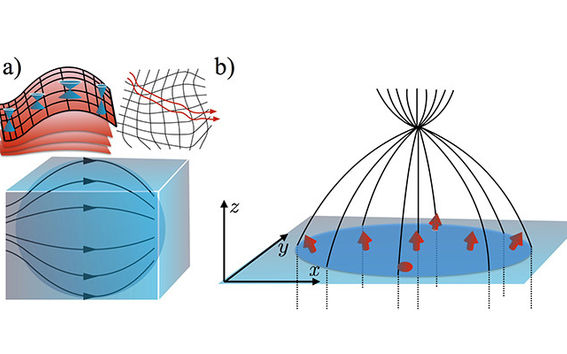Weyl metamaterials offer a novel route to 3D electronic devices

In the new study Aalto University researchers Alex Westström and Teemu Ojanen propose a method to go beyond special relativity and simulate Einstein’s theory of general relativity in inhomogeneous Weyl semimetals. The theory of Weyl metamaterials combines ideas from solid-state physics, particle physics and cosmology and point a way to fabricate metallic designer materials where charge carriers move like particles in a curved space-time.
The researchers propose Weyl metamaterials, a generalization of Weyl semimetals, that enable new types of electronic devices through geometry engineering.
“The systems we introduced offer a route to make the charge carriers move as if they were living in a curved geometry, providing a tabletop laboratory for simulating curved-space quantum physics and certain cosmological phenomena,” explains Alex Westström.
Weyl semimetals are one example of recently discovered quantum materials that have received a lot of attention. Charge carriers in these materials behave as if they were massless particles moving at the speed of light.
“We discovered that Weyl metamaterials may serve as a platform for exotic electronic devices such as the 3d electron lens, where the trajectories of charge carriers are focused much like beams of light in an optical lens,” says Aalto University Docent Teemu Ojanen.
The electric conduction in Weyl semimetals reflects the physics of Einstein’s special theory of relativity. Nevertheless, special relativity also assumes an absence of gravity, which Einstein formulated as a geometry of space-time.
The theory of Weyl metamaterials also pave the way for fundamentally new electronics applications, for instance the development of electronic invisibility devices. The key idea behind the potential applications is an artificially created curved geometry, which bends the motion of charge carriers in a controlled way.
“In optics it has been known for centuries that light always chooses a trajectory which is the quickest. In a curved geometry, the quickest path does not look like a straight line for those watching outside. The functionality of optical invisibility devices where the beams of light bypass a hidden object is in fact based on application of curved-space geometry. It would be a breakthrough in fundamental research to achieve similar functionality in electronic systems”, adds Ojanen.
The research results were published in Physical Review X on October 29, 2017. The study was performed at Aalto University’s Department of Applied Physics, in the group Theory of Quantum Matter. The Academy of Finland funded the research.
Further information:
Teemu Ojanen
Docent
Aalto University
[email protected]
Read more news

Get to know us: Associate Professor Maria Sammalkorpi
Sammalkorpi received her doctorate from Helsinki University of Technology 2004. After her defence, she has worked as a researcher at the Universities of Princeton, Yale and Aalto.
Aalto computer scientists in ICML 2024
Computer scientists in ICML 2024
In low-hierarchy organisations, even key policy issues are discussed in Slack
In a recent study, Aalto University alumn Lauri Pietinalho, a visiting scholar at New York University's Stern School of Business, and Frank Martela, an assistant professor at Aalto University, investigated how low-hierarchy organisations deal with shared policies in confrontational situations and how authority functions within them.